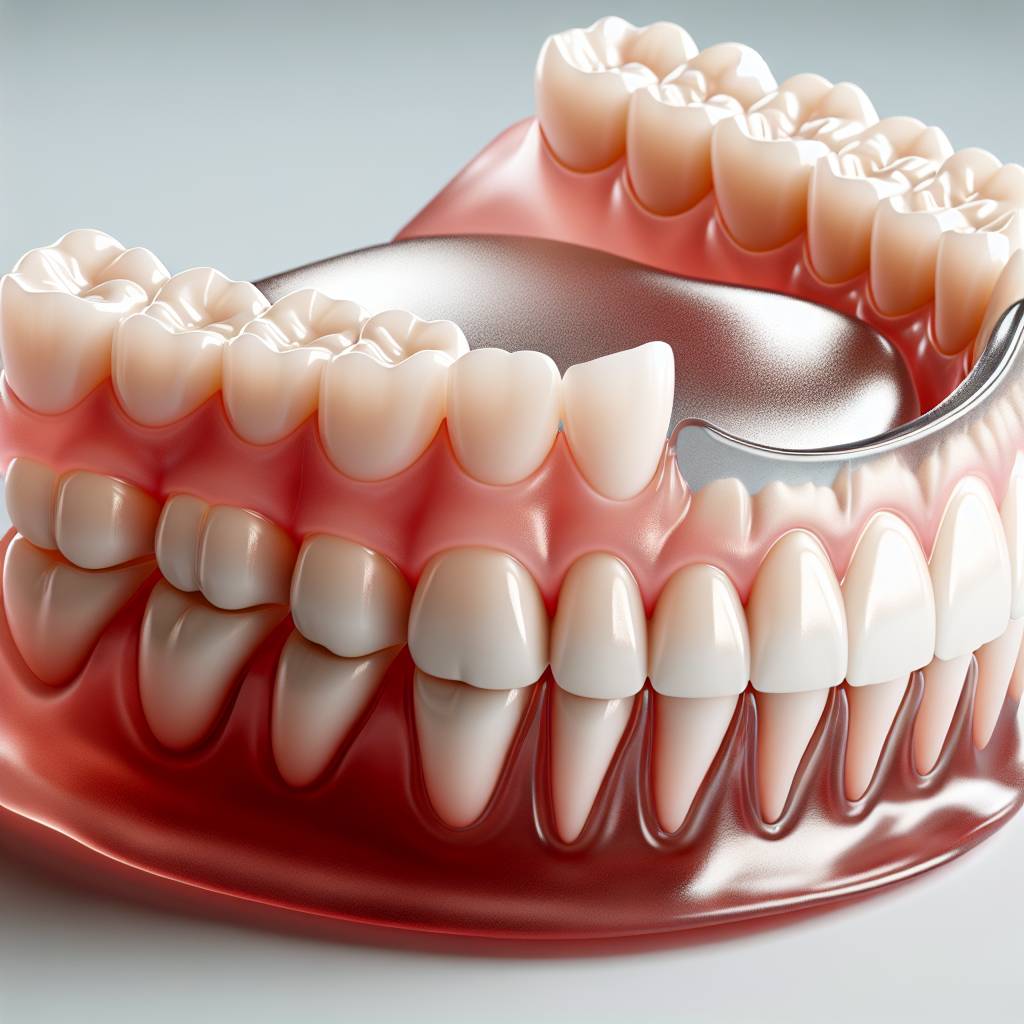Partial dentures are a great option for replacing missing teeth. They are removable, custom-made prosthetic devices that replace one or more teeth in the upper or lower jaw. Partial dentures can be used to replace multiple teeth, and they may also be used to fill in gaps created by missing teeth. This article will provide an overview of how many teeth a partial denture can replace.A partial denture can replace up to three or four missing teeth in a row. The number of teeth that can be replaced with a partial denture will depend on the type of partial used and the remaining teeth in the dental arch.
Types of Partial Dentures
Partial dentures are removable dental appliances used to replace one or more missing teeth. They are typically made from metal and plastic components and can be custom-fit to the patient’s mouth. There are several different types of partial dentures available, each with its own unique benefits and drawbacks. The most common types of partial dentures include:
Acrylic Partial Dentures
Acrylic partial dentures are the most popular type of removable partial denture. They consist of a pink acrylic base that fits over the gums, with replacement teeth attached to it. These appliances can be custom-fitted to the patient’s mouth for a comfortable fit and attractive appearance. Acrylic partial dentures are usually less expensive than other types, but they may need to be replaced more frequently due to wear and tear.
Cast Metal Partial Dentures
Cast metal partial dentures are made from a combination of metals such as chrome and cobalt alloys. These appliances are designed for strength and durability, making them a great choice if you need a long-term solution for missing teeth. Cast metal partials also offer superior stability compared to other types, so they won’t slip or move around when you eat or speak. Unfortunately, cast metal partials can be quite expensive, making them cost-prohibitive for some patients.
Flexible Partial Dentures
Flexible partial dentures use thin plastic material instead of metal for more comfort and flexibility in the mouth. They don’t require any clasps or attachments, so they’re easier to insert and remove than conventional partials. Flexible partials tend to be more affordable than cast metal partials, but they may not last as long due to their thin material construction.
No matter which type of partial denture you choose, it’s important that you discuss your needs with your dentist in order to find the best option for you. Your dentist can provide advice on which type will work best for your particular situation and budget in order to ensure a comfortable fit and lasting results.
What Is Involved in Getting a Partial Denture?
Partial dentures are removable dental appliances that are used to help replace missing teeth. Getting a partial denture typically involves several steps. These include a consultation with your dentist, where they will determine whether you are a good candidate for this type of treatment, and to discuss the options available to you. Your dentist will also take impressions of your mouth to create models for the fabrication of the denture. During this process, any remaining teeth may need to be prepared for the partial denture by filing them down or removing them altogether. Once the models have been made, your dentist will fit you with a trial partial denture that can be adjusted as needed before the final one is made. Finally, when the final denture is ready, it will be fitted to your mouth and any necessary adjustments will be made to ensure a comfortable fit.
Partial dentures can help restore function and aesthetics to your smile and provide an effective tooth replacement solution for those who have lost some of their teeth due to injury or disease. With proper care and maintenance, partial dentures can last years before needing replacing or adjusting.
Benefits of Partial Dentures
Partial dentures offer a wide range of benefits for those who may not have enough remaining healthy teeth to support a full denture. Patients with partial dentures are able to enjoy the following advantages:
Firstly, partial dentures provide an improved aesthetic appearance. They can be used to fill gaps between teeth, helping to restore the natural line of the smile. This can improve confidence and self-esteem as well as providing a more attractive appearance.
Secondly, partial dentures help to maintain jawbone density and facial structure as they are held in place by clasps that attach to existing healthy teeth. This helps to ensure that the overall shape of the face is not changed over time, and that the jawbone density does not decrease due to lack of stimulation.
Thirdly, partial dentures offer improved comfort and function when compared with traditional removable dentures. They are designed for optimal fit and feel, allowing patients to speak, chew and smile without difficulty or discomfort.
Finally, partial dentures are an economical solution for tooth replacement when compared with other options such as bridges or implants. They also require less maintenance than full dentures as they only need to be taken out once a day for cleaning.
Overall, partial dentures provide an effective solution for those who may not have enough healthy teeth remaining for a bridge or implant. They offer improved aesthetics, better comfort and function as well as being more economical than other forms of tooth replacement.
Advantages of Partial Dentures
Partial dentures offer several advantages for those who are missing some of their teeth. They are an affordable option and can be fitted quickly and easily. Partial dentures can also help maintain the shape of the face and jaw by preventing further bone loss that occurs when teeth are missing. Additionally, partial dentures can help improve the wearer’s speech, eating ability, and overall self-confidence. They also make it easier to clean the remaining natural teeth, which helps to prevent tooth decay.
Disadvantages of Partial Dentures
Despite their many advantages, there are some potential drawbacks to partial dentures that should be considered. For one, they may not fit as securely as a full set of dentures or dental implants. They may also cause discomfort or pain in the gums or mouth due to ill-fitting pieces or pressure from the clasps that hold them in place. In addition, it is important to take extra care when cleaning partial dentures to ensure that all food particles are removed from between the teeth and gums. If not properly cared for, partial dentures can cause gum disease or other oral health issues.

Cost of Partial Dentures
The cost of partial dentures can vary widely depending on the type and complexity of the denture. Full dentures, which replace all teeth on either the upper or lower jaw, will typically be more expensive than partial dentures, which replace only a few missing teeth. The materials used in the construction of the denture also play a role in determining the cost. Generally, metal-based partial dentures are more costly than acrylic-based dentures. Other factors that may affect the cost of a partial denture include the number of appointments required for fitting and adjustments, any special features requested for comfort or aesthetics, and any laboratory fees associated with fabrication. Additionally, it is important to consider ongoing costs such as replacement teeth as needed and regular professional maintenance.
When considering purchasing a partial denture, it is important to be aware that different dental care providers may charge different rates for similar services. It is often beneficial to shop around and compare prices before making a decision. Additionally, many dental insurance plans cover at least part of the cost for partial dentures; therefore it is important to review your coverage before purchasing a new set of false teeth.
Daily Care
Proper daily care is essential for partials. It is important to brush and floss the partial daily, just like natural teeth. Brushing removes plaque and food particles, preventing bad breath and gum disease. Flossing helps to remove debris from between teeth and around the gums. A special cleaner designed for partials should also be used every day to help keep the partial free of bacteria that can cause decay or bad odor. Partials should be rinsed with warm water after eating or drinking anything other than water.
Cleaning
Partials should be cleaned on a regular basis with a soft toothbrush and mild soap or a special cleaner designed for partials. If using soap, rinse thoroughly to remove any soapy residue that may remain on the partial after cleaning. The partial should then be dried with a soft cloth or paper towel before being put back in place in the mouth.
Maintenance
Partials should be checked periodically by a dentist or hygienist for proper fit and function, as well as any signs of wear or damage that may need to be repaired or replaced. If necessary, adjustments can also be made by a dental professional to ensure a comfortable fit and proper function of the partial denture.
Care Tips
It is important to store partials in a cool, dry place when not in use and never leave them in direct sunlight. Avoid using hot water on partials as it can cause them to warp or crack over time. Partials should never be placed in boiling water, dishwashers, ultrasonic cleaners, or bleach solutions as this can cause permanent damage to the partial’s material and components.
Food Restrictions with Partials
Partial meal plans involve reducing the number of foods a person eats. This helps to reduce the amount of calories that are consumed and can help people reach their goal weight. Additionally, it can help to reduce the risk of developing chronic diseases, such as heart disease and diabetes. Partial meal plans can be tailored to fit an individual’s food preferences, health needs, and lifestyle. For example, someone who wants to lose weight may restrict carbohydrates while someone who has high blood pressure may restrict sodium.
Partial meal plans are not intended as a long-term solution, but rather as a way to jumpstart healthy eating habits. In order to maintain a healthy diet, it is important to include a variety of nutritious foods in one’s diet. This includes lean proteins, healthy fats, whole grains, fruits and vegetables. Additionally, it is important to limit processed and fast foods as these are often high in calories and low in nutrients.
It is also important for people on partial meal plans to be aware of potential nutrient deficiencies and work with a healthcare provider or registered dietitian when making changes to their diets. They should consider taking vitamin supplements or adding nutrient-dense foods such as leafy greens or nuts into their meals. Additionally, it is important for people on partial meal plans to make sure they are getting enough water each day in order to stay hydrated and support overall health.
Overall, partial meal plans can be an effective tool for those looking to jumpstart their weight loss journey or make dietary changes that support their overall health goals. However, it is important for individuals on these plans to speak with a healthcare professional about any potential risks or nutrient deficiencies before starting any plan.

Conclusion
A partial denture is a great option for replacing multiple teeth. It is a cost-effective and non-invasive way to restore your smile. Additionally, it can help restore your ability to chew and speak properly. Partial dentures are designed to fit in with your existing teeth, making them a great choice for those with gaps in their smiles. With proper care, partial dentures can last for many years.
Overall, the number of teeth that a partial denture can replace depends on several factors including the shape of the patient’s mouth, the number of natural teeth remaining, and the type of partial denture being used. Dentists will assess each patient’s unique situation and provide advice on the best type of partial denture that will provide the most effective results.
Partial dentures are a great way to replace missing teeth without invasive procedures such as implants or bridges. They are also easy to maintain and keep clean with regular brushing and flossing. With proper care, partial dentures can last for many years, making them an attractive option for anyone looking to restore their smile.

